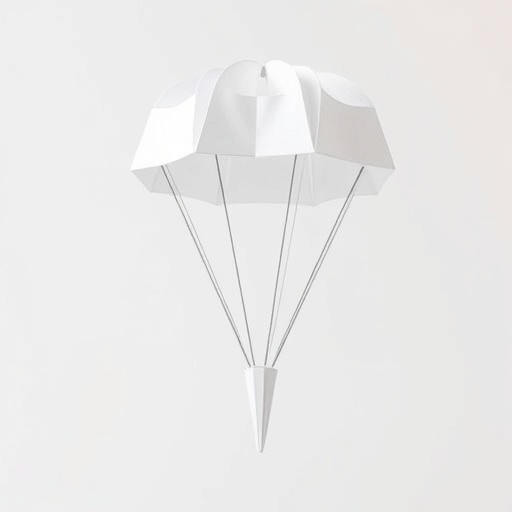In a groundbreaking fusion of art and engineering, researchers have unveiled a revolutionary approach to parachute design inspired by the ancient Japanese craft of kirigami. This technique, which harnesses the principles of strategic cutting patterns on sheets, allows materials to flex and fold into complex three-dimensional forms. The innovation, detailed in a recent Nature publication, promises to transform parachutes from fragile, costly devices into robust, easily manufactured aids poised to revolutionize humanitarian airdrops and drone logistics.
Kirigami, distinct from origami through the incorporation of cuts alongside folds, has long fascinated scientists for its ability to imbue flat sheets with remarkable mechanical properties. By carefully programming patterns of cuts, sheets can expand, contract, and morph with extraordinary precision, enabling a design space ripe with novel deformation behaviors. Such characteristics have already found uses ranging from soft robotics to metamaterials. However, applying kirigami principles to aerodynamic structures like parachutes introduces a bold new chapter in both fields.
The research team approached the challenge by laser-cutting closed-loop kirigami patterns into otherwise solid discs, effectively introducing porosity and intentional flexibility. These cuts not only reduce the material weight but also facilitate controlled reconfiguration when exposed to fluid flow, a feature critical for parachutes which must remain stable during descent. Unlike traditional designs that rely on fabric tension and canopy geometry to modulate drag and stability, kirigami-inspired parachutes harness deformation as an active mechanism to regulate their descent.
Crucially, the team combined experimental wind tunnel tests with sophisticated numerical simulations that model the complex fluid-structure interactions these designs undergo in motion. Their simulations leveraged a custom flow-induced reconfiguration model capable of predicting how the patterned sheets distort under aerodynamic loading. This hybrid approach enabled rapid iterative design cycles, refining cutting patterns to deliver optimized parachute performance before physical fabrication.
Fabrication efforts spanned from prototype scales of centimeters up to full-scale parachutes measuring meters across, showcasing the scalability of the kirigami approach. Tests conducted under realistic environmental conditions demonstrated that at low load-to-area ratios, these kirigami parachutes achieve terminal velocities closely matching those of their conventional counterparts. By maintaining comparable descent speeds, they ensure reliable payload delivery without sacrificing safety or control.
Perhaps most strikingly, these kirigami designs exhibit unparalleled vertical stability during descent. Whereas traditional parachutes must deploy at specific angles and can drift unpredictably with wind currents, the kirigami variants consistently fall near predetermined targets irrespective of their release orientation. This reconfiguration-driven stability is a profound advantage in scenarios demanding precise placement, such as delivering medical supplies to remote areas or deploying delicate instruments via drones.
The implications for humanitarian aid are especially compelling. Conventional parachutes are often prohibitively expensive for mass deployment in crisis zones, and their delicate construction increases the risk of loss or damage. By contrast, kirigami-inspired parachutes can be laser-cut rapidly and economically from lightweight materials, reducing both production complexity and cost. Additionally, their durable, reconfigurable structure could dramatically decrease material waste, optimizing resource use in large-scale airdrop operations.
Moreover, the versatility of kirigami patterns could pave the way for parachutes tailored to specific mission requirements. By adjusting cut geometries and densities, designers can fine-tune parachute properties such as drag coefficient, deployment behavior, and stability profile without altering the base material or assembly process. This parametric control opens avenues toward adaptive parachute systems capable of responding dynamically to environmental conditions or payload variations.
From an engineering perspective, this development exemplifies the power of integrating mechanical metamaterials concepts into practical design challenges. The marriage of kirigami-inspired morphing structures with aerodynamic functionality underscores the potential of programmable materials to transcend traditional limitations. By blurring the boundaries between passive geometry and active mechanical response, the team has crafted a new class of deployable devices that rethink how shapes interact with their surrounding fluid environment.
Looking ahead, further optimization of kirigami parachutes could involve embedding sensors or actuators that monitor or influence deformation in real time, enabling intelligent behavior mid-flight. Such advancements would enhance precision delivery capabilities and expand the range of supported payloads. Additionally, adapting kirigami principles to other forms of aerodynamic deceleration or reentry systems might yield broader aerospace applications beyond parachutes.
This pioneering work exemplifies how ancient artistic traditions like kirigami can inspire transformative engineering solutions. By distilling the elegant interplay of cuts and folds into mathematical models and then realizing those designs at operational scales, the researchers open a pathway to smarter, more efficient airborne delivery systems. Their findings herald a future where pliable, responsive materials supplant rigid constructs, empowering novel approaches to some of today’s most pressing logistical challenges.
In essence, kirigami has emerged not only as an aesthetic craft but as a linchpin for future technologies demanding adaptability, precision, and robustness. The kirigami parachute stands as a testament to the fusion of art and science, redefining what is possible in the skies above humanitarian missions and beyond.
Subject of Research: Kirigami-inspired reconfigurable parachute design and fluid-structure interaction for improved airdrop performance
Article Title: Kirigami-inspired parachutes with programmable reconfiguration
Article References:
Lamoureux, D., Fillion, J., Ramananarivo, S. et al. Kirigami-inspired parachutes with programmable reconfiguration. Nature 646, 88–94 (2025). https://doi.org/10.1038/s41586-025-09515-9
Image Credits: AI Generated
DOI: https://doi.org/10.1038/s41586-025-09515-9





